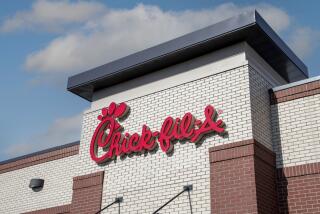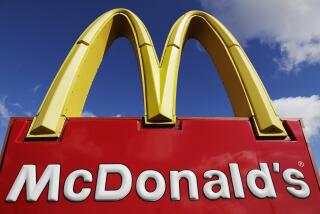Would you like TV with that Big Mac?
- Share via
McDonald’s customers will soon be able to have local school sports, movie previews and heartwarming human interest stories to go with their fries -- McTV is here and in high definition.
In one of the most unusual twists in niche programming, the global fast-food chain is launching the McDonald’s Channel, a digital network of exclusive original content targeted at dine-in customers. The programming will be customized to specific communities around the individual restaurants, and will include local news and entertainment features, such as spotlights on upcoming films, albums and TV shows.
McDonald’s move is part of a broader digital-age strategy by corporate America to create its own platforms to speak directly to customers in an environment uncluttered by other media. Just as individuals have flocked to social media to tell their own stories, McDonald’s is the latest in a growing number of image-conscious corporations and institutions that will reach out to consumers by acting as their own studio and network.
“While they’re in line getting their hamburger there is no escape,” said Allen Adamson, a managing partner of Landor Associates, a firm that specializes in brand building. So-called in-store networks are “one of the last bastions where you have a captive audience,” he added.
Indeed, in the era before cable and the Internet, the three broadcast networks -- CBS, NBC, and ABC -- had a 90% share of the prime-time television audience. Now it is a free-for-all among the broadcast networks, hundreds of cable channels and new competitors for eyeballs such as Netflix, Hulu, YouTube and Facebook.
“The podiums where companies can tell their stories have eroded.... After the Super Bowl the list gets very short very fast,” Adamson noted.
The McDonald’s Channel, being rolled out slowly during the next few months and soon to be up in 800 McDonald’s restaurants in Southern and Central California, is being spearheaded by ChannelPort Communications LLC, a Los Angeles-based company specializing in entertainment content, technology and brand management. Programming will be anything but low-key and grass-roots: Reality TV mogul Mark Burnett (“Survivor,” “The Apprentice,” “The Sing-Off”), BBC America and KABC-TV Eyewitness News are on board to provide content for the new network.
The venture, which has already been tested in L.A., San Diego and Las Vegas, is expected to reach 18 million to 20 million people a month, which ChannelPort executives said would be one of the largest daytime audiences in the region. If successful, the project, which will also include interactive elements on Web and mobile platforms, may expand nationwide.
“The intention is to catch and engage the customer, and then enhance their experience,” said Leland Edmondson, founder of ChannelPort. “The McDonald’s customer is everyone, and we want not to be passive viewers but to be active and participatory with this network.”
The new restaurant TV channel marks another public space where the individual will have trouble escaping the small screen or advertisements.
As corporations find new ways to promote themselves, even routine tasks such as taking a cab, pumping gas or riding an elevator require enduring some form of media.
It used to be that “the television didn’t move,” observed Alison Trope, an associate professor at USC’s Annenberg School for Communication & Journalism. Now, she said, corporations “can tap into anyone’s consumer behavior at every of the day and brand their message.”
One key content provider for McDonald’s will be Vimby, Burnett’s Van Nuys-based digital production company that uses a network of more than 150 filmmakers in 40 cities to generate original programming for the Web, portable devices and television.
“We believe there are so many screens in America that people are able to watch on and aggregate,” Burnett said. “And it’s more than sitting at home watching TV. Our company can do digital content on a national scale but with a local focus.”
The dining areas of participating restaurants will be fitted with two high-definition 42- to 46-inch screens that will be visible from 70% of eating areas. Audio will be heard from the screen or ceiling speakers. Those who do not want to see or hear the channel will be able to eat in “quiet zones.”
The programming will be shown in a one-hour cycle consisting of installments or “pods” lasting 20 to 22 minutes.
Each component will have several segments that include “The McDonald’s Achievers,” which will profile local high school and college athletes; “Mighty Moms,” a focus on local moms juggling home life with careers in sports such as coaching or training; “McDonald’s Channel Music News” about musical acts, tours and new releases; and Burnett’s “Vimby,” which will cover fashion, art, music, night life, lifestyle and culture news.
About eight minutes an hour will be devoted to advertising, and McDonald’s ad participation will be only a minute and a half, Edmondson said: “This network is not intended to be all about McDonald’s. It is all about the consumer.”
He noted that there may be segments about McDonald’s centering on features of the food operation or about philanthropy efforts by Ronald McDonald House Charities.
McDonald’s executives also see their new channel as a way to make their restaurants more than just a place to grab a quick bite -- about 70% of the restaurant’s business is drive-though. The programming will offer another reason to spend more time visiting with families and friends in the restaurants, many of which feature playground areas and cafe elements, officials say.
“People today are using our restaurants differently than they have in the past,” said Danya Proud, a spokeswoman for McDonald’s USA.
“They’ve become more of a destination. With McDonald’s restaurants offering Wi-Fi, we’ve become more relevant and contemporary.”
More to Read
The biggest entertainment stories
Get our big stories about Hollywood, film, television, music, arts, culture and more right in your inbox as soon as they publish.
You may occasionally receive promotional content from the Los Angeles Times.











